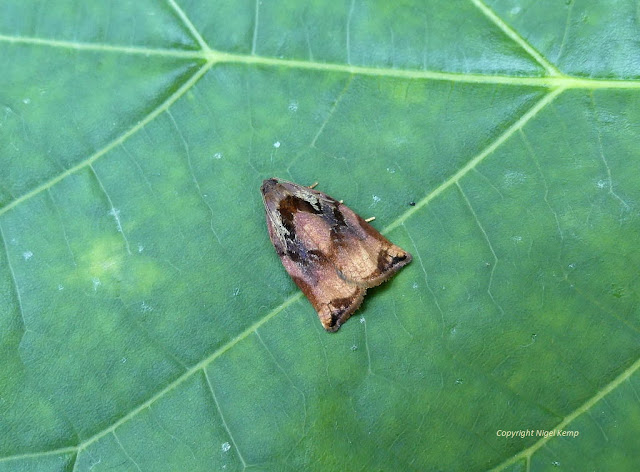Following on from my blog post from 2017 entitled "Life Cycle of the White Admiral", this year I was keen to observe more of the life cycle of the White Admiral (Limenitis camilla), in particular the development of the pupa and emergence of the adult butterfly. I was equally keen to make these observations in the wild.
I began my search for a fifth instar larva during the last week of May and on the 27th. I found a candidate busily feeding on honeysuckle, about 6 feet from the ground.
For the next four weeks I was able to make almost daily visits to monitor its progress.
The photographs were taken in subdued light. I have not used any flash so as to show the larva and pupa at one with their natural surroundings.
27th May, 5th. instar larva feeding on honeysuckle.

27th May, same larva in defensive posture.
2nd, June, larva at rest.
4th, June, the larva is resting on top of a leaf on a very wet day.
7th. June, final instar larva preparing to pupate.
8th. June, the larva has shed its final skin and pupated (day 1)
The reflective mirrors are yet to develop.
9th. June, the pupa (day 2)
The silver-gilt mirrors are developing.
14th. June, the pupa (day 7)
20th. June, the pupa (day 13)
The pupa of the White Admiral is a wonderful piece of evolutionary design and although it has the look of a folded honeysuckle leaf, I think that the pupa is a master of illusion. When it is seen against a woodland background, with all its shadows and reflections, the silver-gilt mirrors and dark markings and projections very successfully break up the outline and form of the pupa. On several occasions, even though I knew where it was, I looked past it before I eventually focused on it.
22nd. June, the pupa (day 15)
There is an almost imperceptible change as the green colour starts to dull and the head darkens.
23rd. June, the pupa (day 16)
The darkening of the green areas have become more obvious.
24th. June, the pupa (day 17)
The pupa is now much darker and the wing markings are just starting to show through the pupal membrane.
25th. June, the pupa (day 18)
The pupa is now virtually black and the white wing markings are clearly visible through the pupal membrane.
26th. June, the pupa (day 19)
Translucent areas on the pupa show that the butterfly within has separated from the pupal membrane.
Emergence is imminent.
26th. June, the pupal membrane breaks open and the butterfly emerges.
A male White Admiral is ready for its first flight.















































